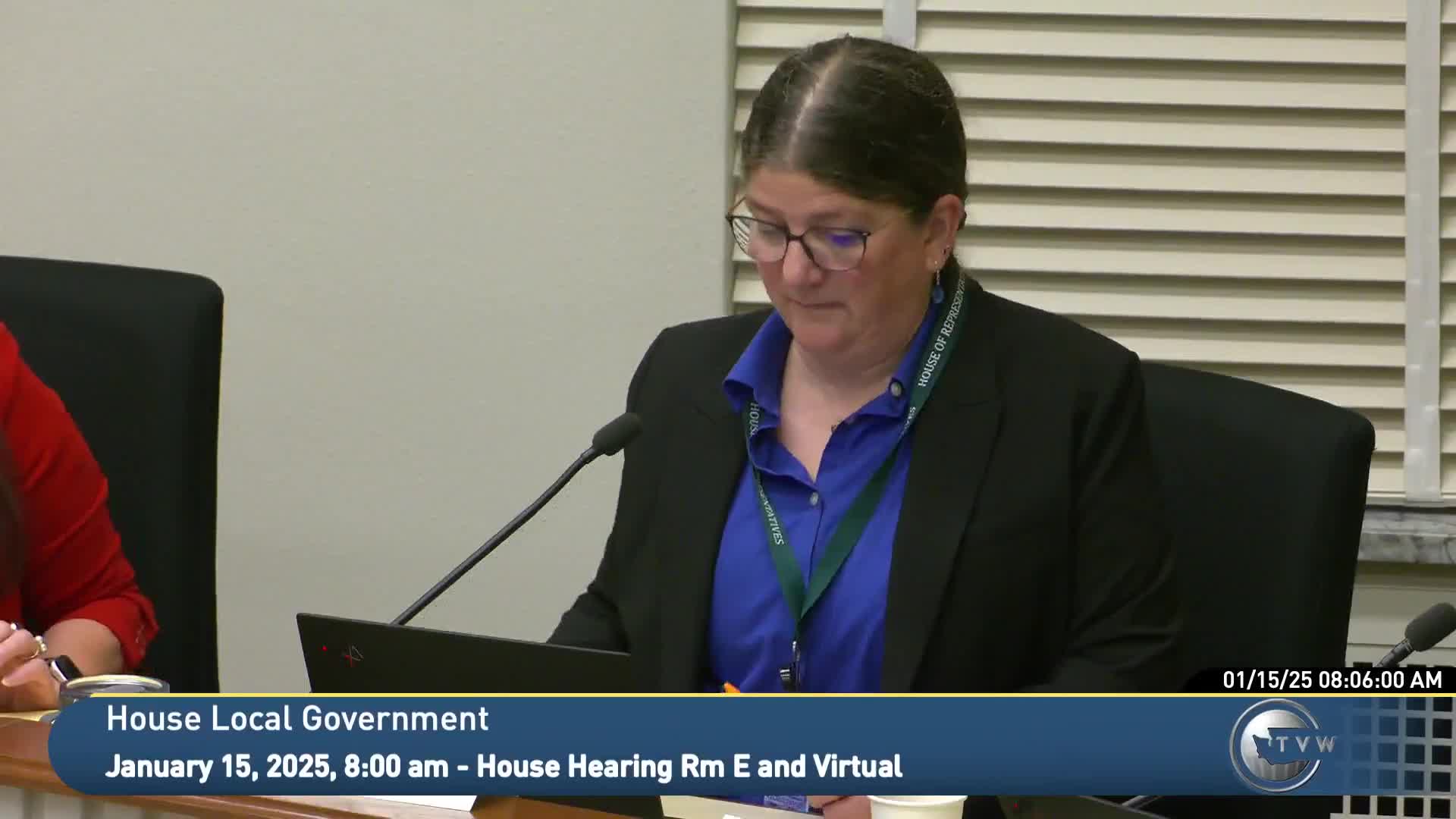CPARB proposes 10% cap, tighter language for new $300,000 self‑perform allowance under HB 1621
January 15, 2025 | Local Government, House of Representatives, Legislative Sessions, Washington
This article was created by AI summarizing key points discussed. AI makes mistakes, so for full details and context, please refer to the video of the full meeting. Please report any errors so we can fix them. Report an error »

Representatives of the Capital Projects Advisory Review Board urged the Local Government Committee to clarify and narrow a new category of public self-performance work created under recent legislation.
Lyneth Riley Hall, chair of the Capital Projects Advisory Review Board, told the committee the board has completed stakeholder work and identified recommendations to address confusion that arose after the 2024 changes to bidder-responsibility and self-performance thresholds.
The recommendations would: eliminate alternative bidder-responsibility provisions and instead reference RCW 39.04.350 for consistency; remove exceptions that excluded materials and equipment from a new $300,000 self-perform threshold; replace the phrase "prudent utility management" with a narrower definition, "exigent circumstances;" and add an annual cap so that cumulative $300,000 self-perform projects would not exceed 10% of an entity's annual capital budget.
Why it matters: The state's changes last year raised the single-craft and multiple-craft thresholds (to roughly $75,000 for a single craft and $150,000 for multiple crafts) and introduced the new $300,000 category. CPARB members said those increases and the new exceptions have caused uncertainty for contractors and public owners about when self-performance is permitted.
Board vice chair Keith Michel, who co-chaired the CPARB review committee, said the board recommended replacing "prudent utility management" with "exigent circumstances" to narrow the category. "Exigent means not an emergency, but urgent," Michel said, describing circumstances such as time-related environmental or safety risks that might justify self-performing work up to the $300,000 threshold.
Committee members pressed presenters on how the 10% cap would affect cities and special-purpose districts. The 10% figure, presenters said, was drawn from an existing first-class city statute that limits in-house crews to no more than 10% of capital project spending; CPARB proposed applying a similar annual cap across entities as a straightforward safeguard.
Members also asked about operational impacts. A CPARB member explained that public entities still must evaluate their own capabilities for any given project and that bidder-responsibility criteria in the proposed language would preserve an entity's ability to compare bids and, in some circumstances, cancel a solicitation and self-perform the work.
Concerns remained. Several committee members said special-purpose districts and smaller jurisdictions may face different budgetary and staffing realities than larger cities, and CPARB acknowledged it could not reach full consensus because agencies and owners have varying missions and operational structures.
What's next: CPARB said it would finalize model legislative language for the 2025 session and identify bill sponsors. The board recommended a single, consistent set of statutory references across the relevant RCWs to reduce confusion for contractors who work with multiple public owners.
The presentation and discussion at the Local Government Committee combined CPARB's technical recommendations with elected members' questions about practical effects on bidding, prevailing wage concerns, and differences between cities and special-purpose districts.
Lyneth Riley Hall, chair of the Capital Projects Advisory Review Board, told the committee the board has completed stakeholder work and identified recommendations to address confusion that arose after the 2024 changes to bidder-responsibility and self-performance thresholds.
The recommendations would: eliminate alternative bidder-responsibility provisions and instead reference RCW 39.04.350 for consistency; remove exceptions that excluded materials and equipment from a new $300,000 self-perform threshold; replace the phrase "prudent utility management" with a narrower definition, "exigent circumstances;" and add an annual cap so that cumulative $300,000 self-perform projects would not exceed 10% of an entity's annual capital budget.
Why it matters: The state's changes last year raised the single-craft and multiple-craft thresholds (to roughly $75,000 for a single craft and $150,000 for multiple crafts) and introduced the new $300,000 category. CPARB members said those increases and the new exceptions have caused uncertainty for contractors and public owners about when self-performance is permitted.
Board vice chair Keith Michel, who co-chaired the CPARB review committee, said the board recommended replacing "prudent utility management" with "exigent circumstances" to narrow the category. "Exigent means not an emergency, but urgent," Michel said, describing circumstances such as time-related environmental or safety risks that might justify self-performing work up to the $300,000 threshold.
Committee members pressed presenters on how the 10% cap would affect cities and special-purpose districts. The 10% figure, presenters said, was drawn from an existing first-class city statute that limits in-house crews to no more than 10% of capital project spending; CPARB proposed applying a similar annual cap across entities as a straightforward safeguard.
Members also asked about operational impacts. A CPARB member explained that public entities still must evaluate their own capabilities for any given project and that bidder-responsibility criteria in the proposed language would preserve an entity's ability to compare bids and, in some circumstances, cancel a solicitation and self-perform the work.
Concerns remained. Several committee members said special-purpose districts and smaller jurisdictions may face different budgetary and staffing realities than larger cities, and CPARB acknowledged it could not reach full consensus because agencies and owners have varying missions and operational structures.
What's next: CPARB said it would finalize model legislative language for the 2025 session and identify bill sponsors. The board recommended a single, consistent set of statutory references across the relevant RCWs to reduce confusion for contractors who work with multiple public owners.
The presentation and discussion at the Local Government Committee combined CPARB's technical recommendations with elected members' questions about practical effects on bidding, prevailing wage concerns, and differences between cities and special-purpose districts.
View full meeting
This article is based on a recent meeting—watch the full video and explore the complete transcript for deeper insights into the discussion.
View full meeting
